Published
on 30
Jun 2018
|
All rights reserved.
|
|
| V60 |
|
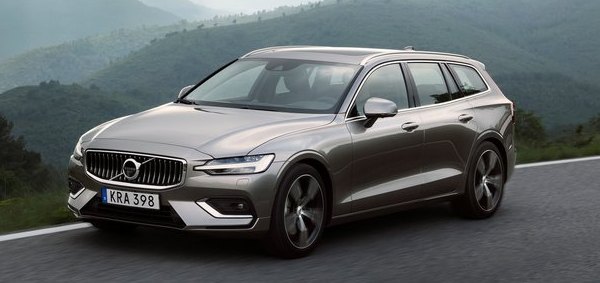
|
|
New
Volvo no longer lives under the shadows of German rivals.
|
|
If every manufacturer
follows Volvo to employ only one engine family and two modular
platforms, writing car reviews would be easier than ever. As model A
and model B are highly in common, reviews could be written in modules,
mix and match to publish. Road tests become unnecessary as you can
already guess the performance and feel of every aspect. Background
information and technical analysis could be copied and pasted from the
last review, or the one preceding it. Many automotive
journalists could lose their jobs as a result, and most alarming, how
boring the automotive world would be!
But I like it! As age grows and my typing hands get heavier and
heavier,
I like this kind of modular cars to save my time. So don’t waste any
time to dig into the spec. sheet of V60, because you already know it
from S90, XC90 and XC60: the SPA (Scalable Product Architecture)
platform is shared among all the larger cars of Volvo (while CMA
platform is for smaller cars). Its chassis comprises of high-strength
steel and a number of aluminum components, including the cast aluminum
front suspension towers, the tower bar and the front crash structure
made of extruded aluminum. Not quite as radical as Mercedes,
let alone Jaguar, but it holds well with Audi and BMW. As a large car
platform it employs a classier double-wishbone suspension up front and
integral link setup at the rear, the latter is unusually equipped with
a composite leaf spring instead of conventional steel coil springs.
Adaptive dampers are optional, but the more expensive air suspension is
reserved for the 90-series cars. No problem, in its class only Mercedes
C-class offers more. Under the bonnet is a range of Drive-E
four-cylinder engines, all displace 2 liters, differing only in the
choice of turbo/supercharger and the state of tune. It makes life
easy for Volvo’s engineers, as they don’t need to design different
engine mounts and tune the suspension differently. Oh yes, don't forget
to mention that SPA is an FWD platform, so it won't freighten BMW.
Designed to accommodate only a four-cylinder engine mounted
transversely, it uses space more efficiently than all the
aforementioned rivals. 4WD is optional, while Volvo's plug-in hybrid
technology, marketed as "Twin Engine", can add an electric motor to the
rear axle. None of these breaks the mold of SPA.
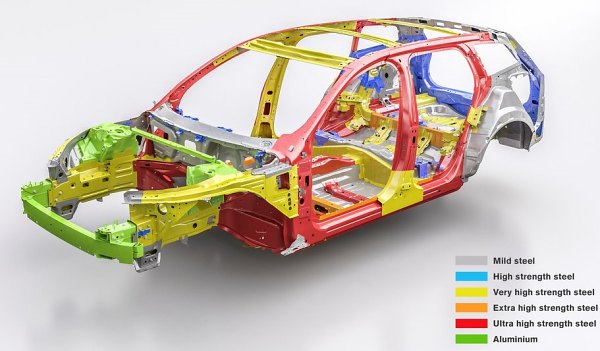
|
|
The
SPA platform is shared among all the larger cars of Volvo.
|
|
The difference between V60 and the 90-series cars lies in size, of
course.
Compared with S90, its wheelbase is 70mm shorter, while its body is
200mm
shorter and 30mm narrower, too. However, bear in mind that it sits on
the same large car platform, it is not surprising to hear that the new
V60 is 126mm longer and runs a 96mm longer wheelbase than its
predecessor. Therefore, it is also larger than any of its German rivals
in the junior executive car segment. The up side is more cabin room and
cargo-carrying capability. The boot now swallows 529 liters of luggage,
again more than its rivals. (A Volkswagen Passat Variant topples all
with 650
liters, but not many people consider it as a true premium car, unlike
Volvo which has successfully lifted its image in the last few years to
level on Mercedes, BMW and Audi). Fold the rear seats and this expands
to 1441 liters, not quite class-leading, but the load bay of Volvo is
flat and accompanied with many convenient features. Its tailgate is
also large and wide. The aperture opens down to the luggage floor, with
no lip to overcome. After all, Volvo is still the expert of wagon.
But most surprising, this car is handsome, even in wagon form. The days
of civilian-tank design have long gone. Style is no longer the victim
of space efficiency. While the S90/V90 is gifted with more width and
length, extra time evolves Volvo’s design to make it even better on the
V60. Its front grille and bumper are more refined. The gently rising
waistline and slightly pronounced fenders contribute to a more dynamic
appearance, while shorter overhangs make it look a bit sportier. The
last S60/V60 had a more radical, coupe-like shape, but the new car
actually looks sleeker, and way more elegant and tasteful. Audi should
be most worried.
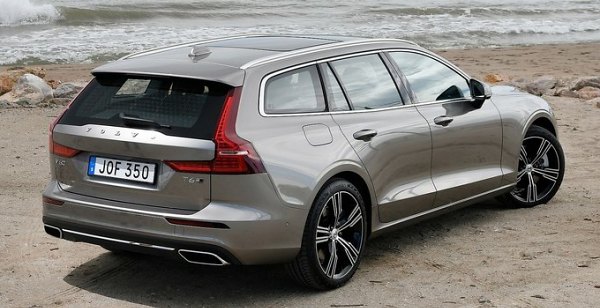 |
|
But most
surprising, this car is handsome, even in wagon form.
|
|
It is fair to say no one in the class builds better cabin than Volvo.
Yes, Audi has higher quality finish and Mercedes feels more luxurious,
but they don’t quite match the Scandinavian ambience – warm and
inviting, high quality but never flamboyant. Its large windows make a
light and airy environment rarely found in the class. Its soft leather,
wood trims and metal accents speak of taste. Its front seats are large
and super comfy. The rear seat has bags of head and leg room, although
the middle passenger has to tolerate the intrusive transmission tunnel.
The dashboard design is unusually clean and free of buttons, a
trademark theme of Volvo since the first SPA car, XC90, launched 3
years ago. The 9.3-inch portrait touchscreen dominates the center
console. Its graphics are fabulous and operation is easy, though you
might want hardware buttons for simple jobs like tuning air-con and
radio. The instrument is a TFT screen which can display a map between
the dials (though not as versatile as Audi Virtual Cockpit). Head-up
display is optional. Moreover, Volvo always comes with the latest
safety systems, including semi-autonomous driving system with automatic
braking and adaptive cruise control. Besides, being a Volvo, 5-star
Euro NCAP rating is a must.
All engines are copied from other SPA cars. Volvo is clever to be able
to build so many variants from the same family. The petrol T5 uses a
turbo to produce 254hp and 258lbft. T6 uses a supercharger for low revs
and a large turbo for high revs, managing a six-cylinder-rivalling
320hp and 295lbft, so strong that AWD is mandatory. Diesel variants of
the Drive-E, namely D3 and D4, makes 150hp and 190hp, respectively,
accompanied with healthy spread of torque. Their differences lie on a
single turbo or a sequential twin-turbo setup. All engines mate with an
Aisin 8-speed automatic.
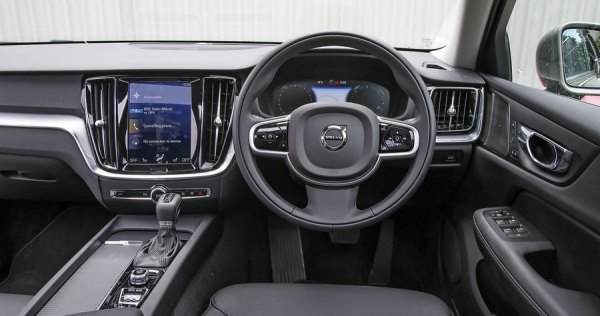 |
|
The dashboard
design is clean and free of buttons, a trademark theme of Volvo since
XC90.
|
|
Overall speaking, we would say these engines are decent for a premium
car like this, but not as remarkable as BMW and Audi’s in terms of
responsiveness, refinement and top-end enthusiasm. The Aisin auto is
not as good as the famous ZF 8HP either, making slower and less
consistent gearshifts. Moreover, the Volvo is considerably heavier than
its rivals, so it will need to work harder for the same pace, which
inevitably results in more noise and vibration. However, if you drive
the V60 in a relaxing way, just as most Volvo drivers do, you are
unlikely to notice its shortcomings, since the car is good at keeping
noises away from its cabin.
In fact, the chassis dynamics are very similar to the powertrains.
Older Volvo owners will be amazed that this car has very decent body
control as well as good grip and braking. The steering is also fast and
surprisingly weighty in Dynamic mode, like a German car, and it
responds with accuracy and linear build-up of load. That said, there is
little sense of what’s going beneath the front wheels through steering.
It doesn’t quite connect to your soul. The more you press it, the more
its essence is revealed. Understeer enters the scene early, and it
feels heavier the more you push. No, Volvo has no intention to
replicate the sporty flavours of BMW and Mercedes with an overweight
FWD platform. All it does is to make it feel agile and composed enough
in normal driving conditions, but its strongest suit is still comfort.
Leave the car in Comfort mode and you will enjoy its superb ride
quality and quietness – both are markedly improved from the last
S60/V60. Relax and enjoy the cabin, it tells you. Whether it is a
better car than BMW and Mercedes depends on your preference and
priority. Keen drivers are of course better served by the German camp
(and don't forget Jaguar XE), but the comfort-oriented route of Volvo
has plenty of followers, too.
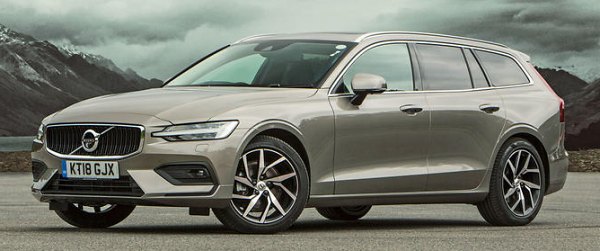
|
|
It feels agile
and composed enough in normal driving conditions, but its strongest
suit is still comfort.
|
|
Having learned this, you will understand that the Twin Engine models
are not exactly performance wagons but a way to achieve low emission
without sacrificing speed. Volvo is the European leader in plug-in
hybrid technology, as it started selling the old V60 Plug-in Hybrid
since 2013. The new model’s technology is developed from that car. It
abandons diesel engine for the cleaner petrol engine of T6, adding a
rear-mounted motor and lithium battery pack (stored under the boot
floor). Motor output has increased by 20hp to 88hp, and the system
output is 390hp. Expect 0-60mph comes in 4.8 seconds. It must be said
that the battery capacity has been reduced slightly from 11.2 to
10.4kWh to make it more packageable, thus its zero-emission range goes
down from 50 to 45km.
The V60 is produced in the Gothenburg and Belgium, with majority of
sales expected to be consumed by Europe. Its sedan variant S60, just
unveiled last week, is produced in the new plant in USA. Both are
likely to gain more ground from their German rivals. Designed with new
found confidence, the mid-size Volvo no longer lives under the shadows
of its rivals.
|
Verdict:     |
| Published
on 2
Nov
2018 |
All rights reserved.
|
|
S60 and S60 T8 Polestar Engineered
|
|
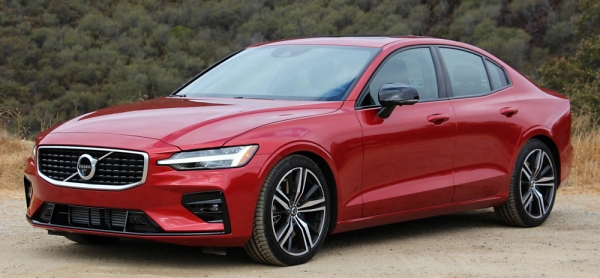
|
|
The
sedan sibling of V60 shares the same virtues and weaknesses.
|
|
Just
a few months ago we learned that the new Volvo V60 is a good executive
car, especially for those seeking comfort, style and practicality. On
the downside, it is overweight, its powertrains are not as good as its
German rivals’ and its handling not sporty enough to delight keen
drivers. What about its sedan sister, the S60?
Unusually, the S60 arrives later than V60. This is understandable if
you consider from the viewpoint of Volvo. The Swedish car maker sells
more estates than sedans in its home market and Europe. Therefore, it
makes more sense to build only the estate version at its home plants in
Gothenburg and Belgium. Once the production is running well, its
production experts can work on satellite plants in China and USA, where
sedans are mainstream choice. China is going to concentrate on the
long-wheelbase version S60L, whereas the newly built USA plant at
Charleston, South Carolina is the production hub of the regular S60,
supplying the global market. It will build around 60,000 units of the
S60 annually, half of them sold locally and half of them to be
exported. By the way, it will be built alongside the XC90, which is
popular to American buyers.
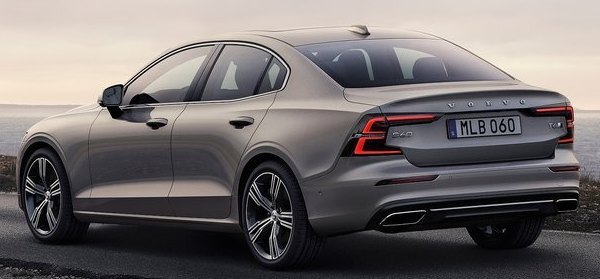
|
|
Better
proportioned than even the S90. Sportier, too.
|
|
Style-wise,
the S60 differs from V60 only from the C-pillars to tail. Compared with
the last generation, its proportion is less sporty – the back is less
steeply raked, and the waistline is not as wedge-shape. However, that
is not to say it is boring. No, with curvier fenders and crisper crease
lines pressed on them, it looks sporty in a different way. The front
grille and headlamps design is more elegant and characterful. Moreover,
the overall proportion is actually more balanced, feeling less
nose-heavy than its predecessor.
It
goes without saying the S60 sits on the SPA platform which underpins
all the
large Volvos, such as S90, XC90, XC60 and V60. This explains why
the S60 grows quite a lot from its predecessor: 133mm in length and
96mm in wheelbase. This improves its rear seat accommodation a lot,
while providing extra space for plug-in hybrid hardware. On the
downside, its luggage space is only 442 liters, compared with 480
liters on BMW 3-Series and Audi A4. Blame the need to accommodate an
electric rear axle. Expectedly, the chassis is just the same as its
estate sibling. It employs a lot of high strength steel and a few
aluminum structural parts, such as the front crash beam and front
suspension towers. Suspensions are double-wishbone type up front, and a
special integral link with transverse composite leaf spring at the
rear. Adaptive dampers are optional, but don't count on air springs,
which is reserved for the 90-series cars.
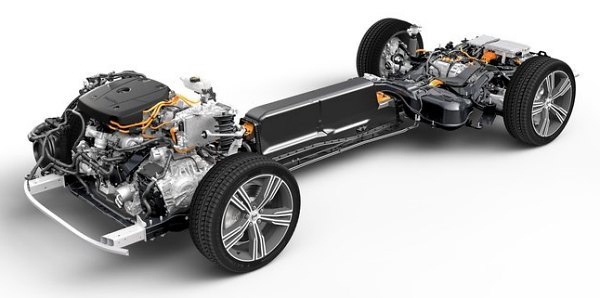
|
|
SPA
platform is compartible with plug-in hybrid technology, or so-called
Twin Engine.
|
|
As its
main markets are outside Europe, the S60 does not offer any diesel
engines. The all-petrol lineup consists of T5 (250hp 2.0 Turbo)
and T6 (320hp 2.0 Turbo+Supercharger). The T6 engine can be added with
a lithium battery in the transmission tunnel and an electric rear axle
to create T6 Twin Engine (340hp) or T8 Twin Engine (400hp). Topping the
range is T8 Polestar Engineered model, which has the petrol engine of
T8 tuned higher, producing a combined 415hp and 494 lbft of torque. It
is claimed to have 0-60mph accomplished in 4.3 seconds, although the
car weighs in excess of 2000kg! Polestar also gave the car plenty of
chassis mods, such as Ohlins DFV adjustable dampers (from the old
S60/V60 Polestar), a front tower brace, stiffer suspensions, lighter
wheels, wider P Zero tires and stronger Brembo brakes.
On the road, predictably, the regular S60 displays just the same
driving manner as V60. Even in the form of 320hp T6 AWD, it is no match
for a BMW 340i. The four-cylinder engine is down on power, response and
aural appeal compared with a six-cylinder. The Aisin automatic gearbox
is lukewarm. The handling is quite good at 8/10ths driving but it will
be prone to understeer and run out of grip sooner than a good
rear-drive machine. The R-Design trim’s 19-inch wheels, 12mm lower and
stiffer suspension might enhance looks, but at the expense of ride
comfort. Avoid R-Design and the S60 should drive as satisfyingly as
V60. It is a good highway cruiser, thanks to a composed ride and superb
NVH suppression on wide open roads. The very comfortable seats and
high-quality interior also impress. Overall speaking, this is a 4-star
effort.
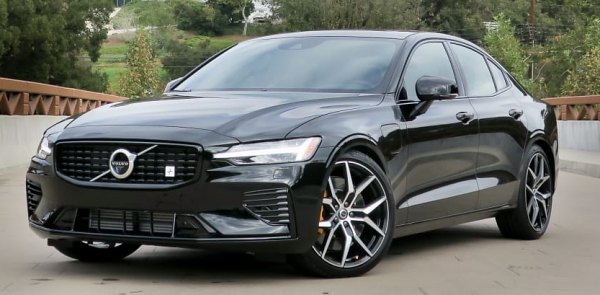
|
|
T8
Polestar Engineered has a unique blend of performance and cultured
manner. Just don't expect it to be the last word of thrills.
|
|
The T8
Polestar Engineered model is more complicated. If you assess it
according to the traditional requirements for sports sedans, I’m afraid
it will fail the test. Although it has its body controlled reasonably
well, find a twisty road and push it harder, you will feel its extra
weight and inertia. You will also feel that it is nose-led, as most of
the power goes through the front wheels. Meanwhile, the steering always
lacks feel to inspire confidence. The braking is effective, but Volvo
fails to rectify the non-linear pedal response typical to hybrid cars,
which might be okay for a Toyota Prius, but unforgivable for a sports
sedan. On the plus side, the Ohlins dual-flow valve dampers work in
magic to provide a better body control yet a noticeably smoother ride
than the lesser T6 R-Design, even though its springs are 5 percent
stiffer than that model. You may also adjust the dampers manually
through 22 clicks, although few Volvo drivers are expected to do so.
Priced at over £50K, the content-rich Polestar is more expensive
than an Audi
S4, matches a Mercedes-AMG C43 and gets very close to the territory of
BMW M3 / Alfa Giulia QF / AMG C63. While the electric boost gives it
some fun at low-speed acceleration, it is still a slower car on
straight, and even slower to lap a track. Its engine lacks a memorable
soundtrack. Its transmission lacks a crisped response. Its steering and
braking lack sharpness. Somewhat like a BMW i8, what it excels is a
unique blend of performance and cultured manner. You can start the car
silently and use
its electric power for up to 28 miles (45km), cruise quietly on highway
with instant boost to spare, and recoup energy from braking to save
fuel. This manner suits Volvo and the S60. Just don’t expect it to be
the last word of thrills. Perhaps this is why
it is called T8 Polestar Engineered rather than simply S60 Polestar.
|
Verdict:
S60:    
S60 T8 Polestar Engineered:   
|
|